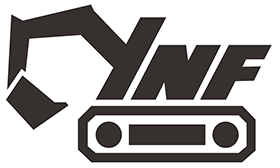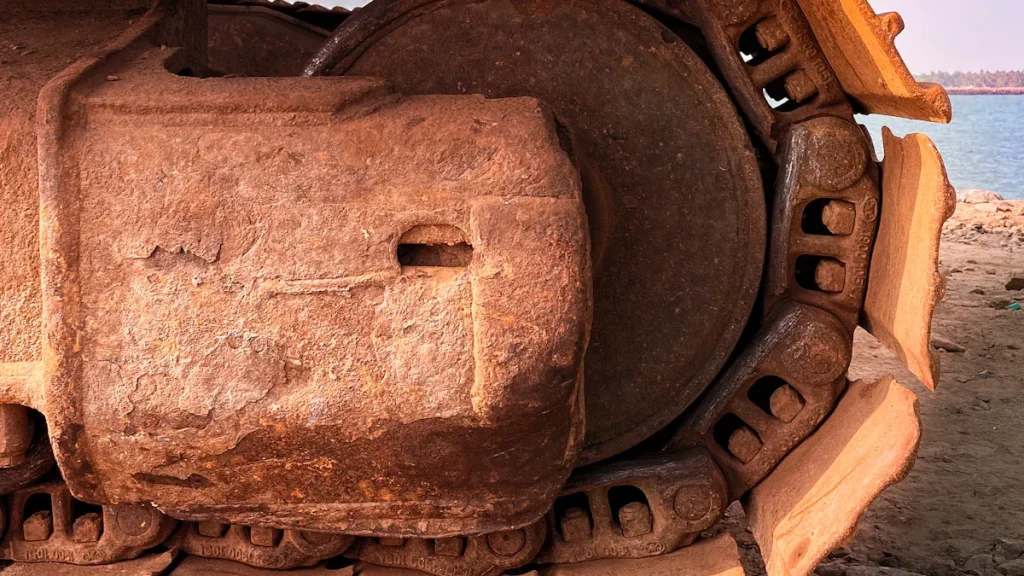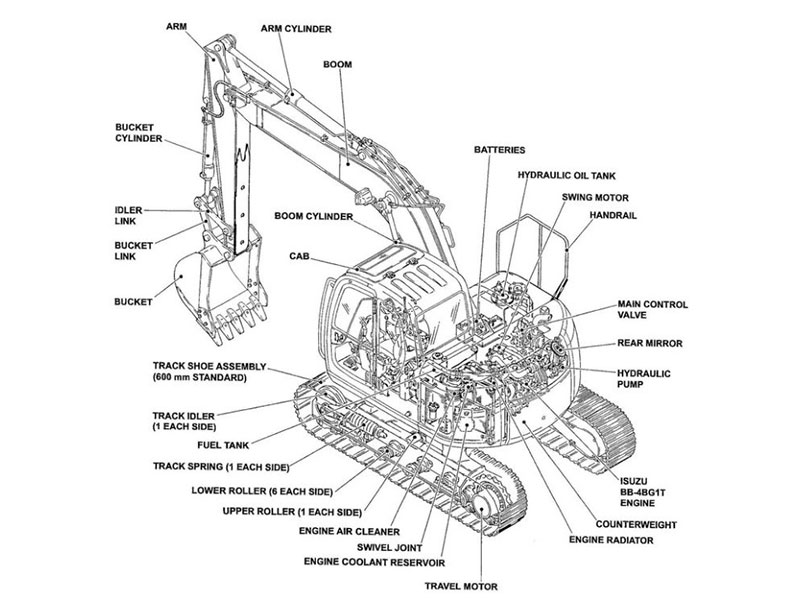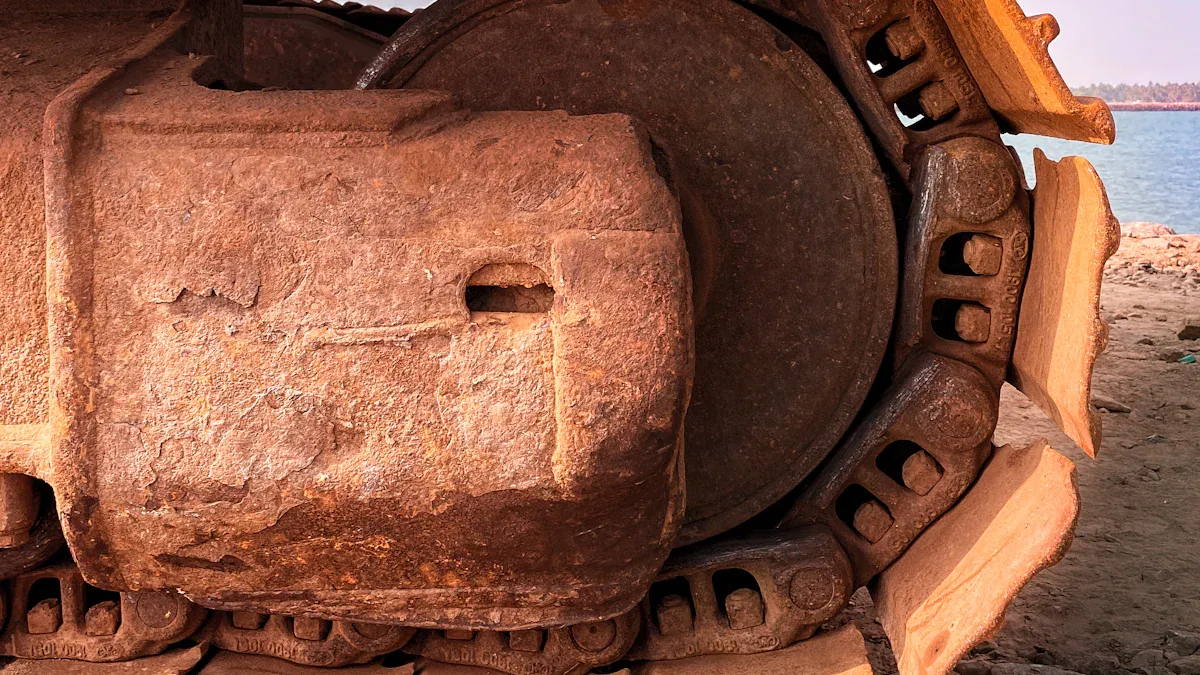
A construction excavator has many important construction excavator parts. These parts work together to help with digging jobs. The main construction excavator parts include the undercarriage, cab, engine, hydraulic system, working arm, counterweight, and attachments. Each construction excavator part helps the machine work safely and efficiently. Operators who understand these construction excavator parts can use the excavator better and safer. Knowing the main construction excavator parts also helps workers maintain the machine and prevent accidents.
Key Takeaways
Excavators have important parts like the undercarriage, cab, engine, hydraulic system, working arm, counterweight, and attachments. These parts work together to help the machine dig and lift things safely.
The undercarriage has tracks and final drives. It helps the excavator move over rough ground. It also keeps the machine steady while it works.
The cab keeps the operator safe. It has controls to run the machine. The house can turn so the operator can reach different spots.
The engine gives power to the excavator. The hydraulic system uses oil pressure to move the arm, boom, and bucket. This helps with digging and lifting.
Checking and taking care of parts like the boom, hydraulic cylinders, counterweight, and attachments is important. This keeps the excavator safe and working well on the job.
Construction Excavator Parts: Undercarriage
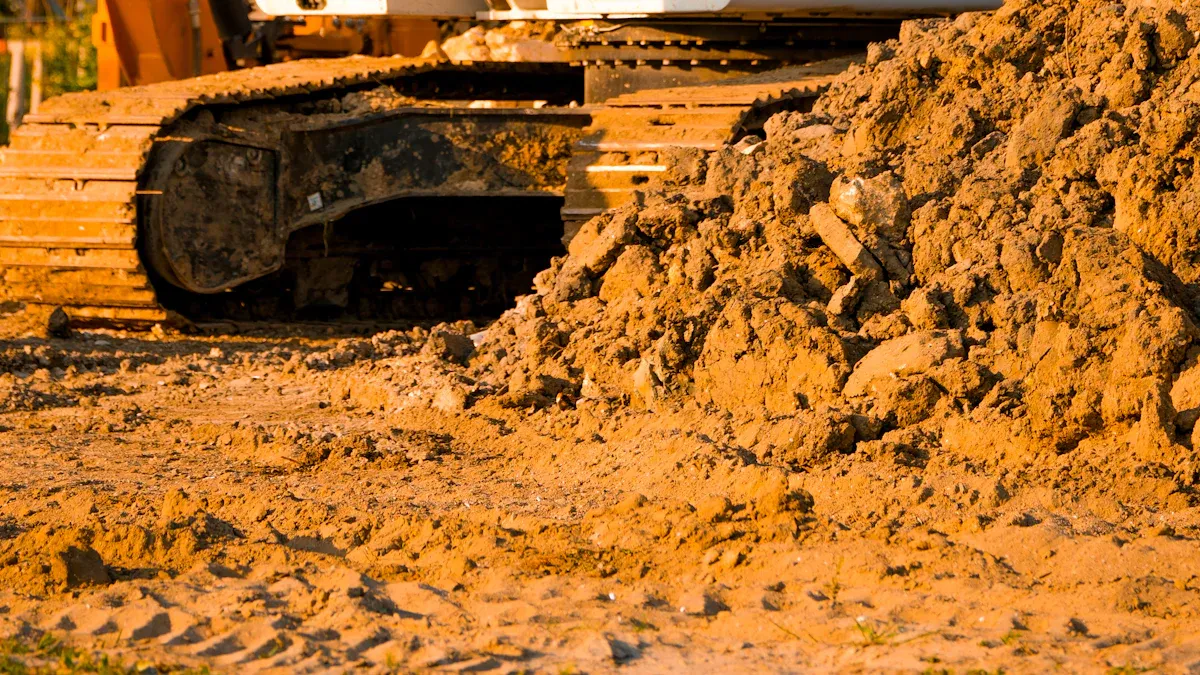
The undercarriage is the bottom part of an excavator. It holds up the whole machine. It helps the excavator move on many surfaces. The undercarriage makes the excavator stable and able to travel. If the undercarriage is weak, the machine cannot dig or lift safely.
Tracks
Excavator tracks look like big belts around the wheels. These tracks help the excavator move on dirt, mud, and rocks. Tracks spread the excavator’s weight over the ground. This stops the machine from sinking into soft soil. Operators use tracks to drive across job sites. Regular wheels would get stuck in rough places. Tracks also help the excavator turn and change direction.
Tip: Tracks should be cleaned often. Dirt and rocks can break them.
Track Frame
The track frame keeps the tracks in place. It connects both tracks and keeps them straight. The frame also holds other construction excavator parts. These include rollers and idlers. Rollers and idlers help the tracks move smoothly. A strong track frame keeps the excavator steady. It helps when digging or lifting heavy things. If the frame bends or breaks, the excavator can tip over.
Final Drives
Final drives are at the ends of the track frame. They use engine power to turn the tracks. When the operator moves the controls, final drives spin the tracks. This lets the excavator move forward or backward. Final drives must stay strong. They handle a lot of force every day. If a final drive breaks, the excavator cannot move.
Part | Main Function | Importance |
|---|---|---|
Tracks | Move the excavator over rough ground | Needed for travel and turning |
Track Frame | Holds tracks and supports rollers | Keeps machine stable and aligned |
Final Drives | Powers the tracks to move the machine | Allows movement and direction |
Knowing about these construction excavator parts helps operators. It helps them keep the machine working well. When every part works, the excavator can move safely and do hard jobs.
Essential Parts of an Excavator: Cab and House
The cab and house make the operator’s area. This part sits above the undercarriage. The cab keeps the operator safe. It lets the operator see the job site well. The house holds the cab and other main parts. These parts help the operator control the excavator safely.
Operator Cab
The operator cab is the main workspace. It has a seat and windows. Safety features are inside the cab. The cab protects the operator from dust and noise. It also keeps out bad weather. Big windows help the operator see the digging area. Some cabs have air conditioning and heating. These make the cab comfortable. Safety bars and seat belts are in the cab. They keep the operator safe while working.
Note: Operators should check the cab before starting work. Make sure windows are clean and safety equipment works.
House Rotation
The house is on top of the undercarriage. It can turn all the way around. This helps the excavator reach many places. The operator uses controls to spin the house. The house can turn left or right. House rotation makes digging and lifting easier. It helps the excavator work in small spaces. The house holds the cab, engine, and hydraulic system. Strong rotation parts help the excavator work well.
Control Panel
The control panel is inside the cab. It has buttons, levers, and screens. These controls move the excavator and change speed. The operator uses them to lift, dig, and turn the house. Some panels show fuel levels and warnings. Easy panels help the operator work safely. Operators learn each control before using the excavator.
Part | Function | Safety Feature |
|---|---|---|
Operator Cab | Protects operator, workspace | Seat belt, safety bar |
House Rotation | Turns house for reach | Strong rotation gears |
Control Panel | Operates excavator functions | Warning lights |
Knowing about the cab and house helps operators stay safe. Each part gives comfort, control, and safety during construction work.
Engine and Hydraulic System
The engine and hydraulic system make the excavator work. These parts help the machine dig and lift heavy things. Operators need to know how these systems work. This helps keep the excavator working well.
Engine
The engine is like the heart of the excavator. It gives power to all other parts. Most excavators use diesel engines. Diesel engines are strong and last a long time. The engine starts when the operator turns the key. This gets the excavator ready for work. The engine also runs the hydraulic pumps.
Operators check the engine before each job. They look for oil leaks and listen for odd sounds. Clean air filters help the engine work better. A good engine helps the excavator dig and lift.
Tip: Let the engine warm up before hard work. This helps the engine last longer.
Hydraulic Pumps
Hydraulic pumps move oil inside the excavator. The engine powers these pumps. Hydraulic pumps send oil to cylinders and motors. This oil makes the arm and tracks move. Without hydraulic pumps, the excavator cannot dig or lift.
There are two main hydraulic pumps in most excavators:
Main pump: Sends oil to the arm, boom, and bucket.
Travel pump: Sends oil to the tracks.
Operators listen for loud noises from the pumps. Strange sounds can mean trouble. Clean oil helps the pumps work well.
Hydraulic Cylinders
Hydraulic cylinders use oil pressure to move parts. These cylinders look like metal tubes with rods inside. When oil goes in, the rod moves in or out. This lifts the boom, moves the arm, or tilts the bucket.
Each part of the working arm has its own cylinder:
Boom cylinder
Arm cylinder
Bucket cylinder
Hydraulic cylinders help the excavator dig and lift. Leaks or dents can stop the excavator from working. Operators check cylinders for leaks and damage.
Fuel and Hydraulic Tanks
The excavator has two main tanks. The fuel tank holds diesel for the engine. The hydraulic tank stores oil for the hydraulic system. Both tanks must stay clean and full.
Operators fill the fuel tank before each shift. They use clean diesel to protect the engine. The hydraulic tank needs the right oil level. Low oil can hurt the pumps and cylinders.
Tank Type | What It Holds | Why It Matters |
|---|---|---|
Fuel Tank | Diesel for engine | Powers the excavator |
Hydraulic Tank | Oil for hydraulics | Moves arm, boom, and bucket |
Note: Only use the oil and fuel types the manufacturer recommends. YNF Machinery gives good parts and advice for excavator care.
The engine and hydraulic system work together. They give the excavator power for tough jobs. Operators who know these parts can keep the machine safe and strong.
Parts of an Excavator: Working Arm
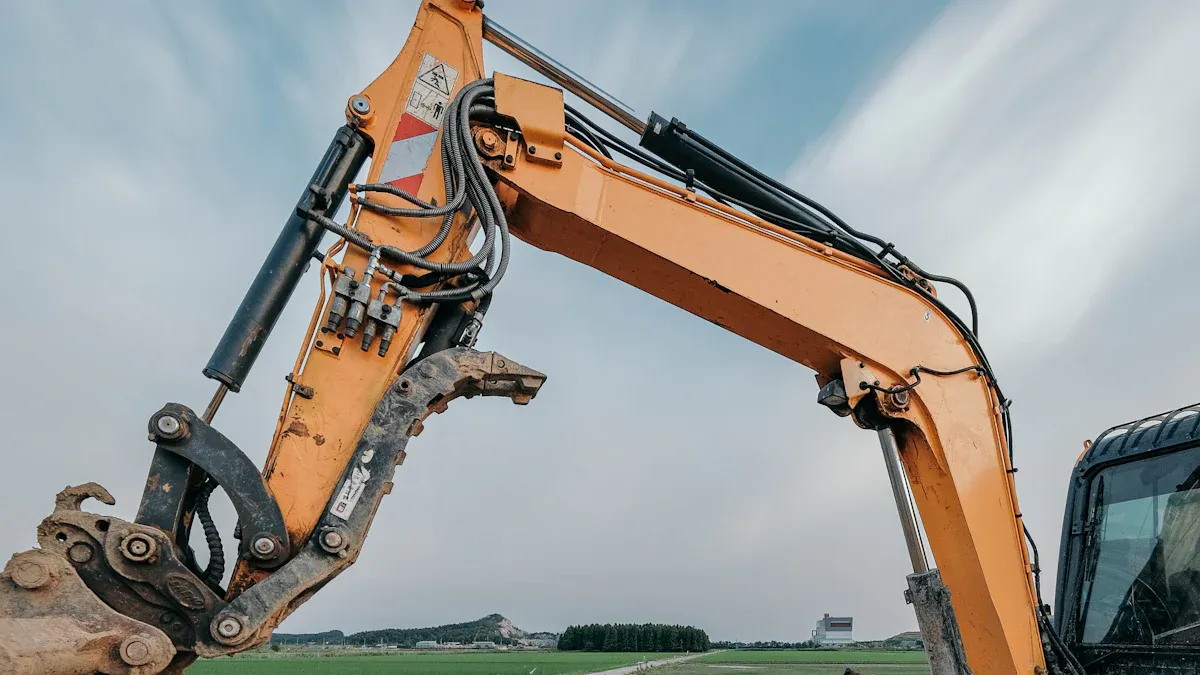
The working arm stands out as one of the most important parts of an excavator. This section includes three main parts: the boom, the arm (also called stick or dipper), and the bucket. These parts of an excavator work together to handle digging and dumping tasks on construction sites.
Boom
The boom connects the house to the rest of the working arm. It acts like a strong lever. The excavator boom lifts and lowers the arm and bucket. This part gives the excavator its reach and height. Workers use the boom to move heavy loads and reach deep into the ground. The boom must stay strong during excavation. If the boom bends or cracks, the excavator cannot dig safely.
Tip: Operators should check the boom for cracks or dents before starting work. A strong boom keeps the machine safe.
Arm/Stick/Dipper
The arm, sometimes called the stick or dipper, attaches to the end of the boom. This part stretches out to move the bucket closer or farther from the excavator. The arm controls how deep the bucket can dig. It also helps with reaching into tight spaces. The arm uses hydraulic cylinders to move quickly and smoothly. When the operator moves the controls, the arm responds right away.
A well-maintained arm helps the excavator finish jobs faster. Operators should watch for leaks or damage on the arm’s hydraulic lines.
Bucket
The bucket sits at the end of the arm. It scoops, lifts, and dumps soil, rocks, or debris. Buckets come in different shapes and sizes for different jobs. Some buckets dig trenches, while others move loose material. The bucket’s teeth help break up hard ground. During digging and dumping, the bucket faces a lot of force.
Part | Main Job | Special Feature |
|---|---|---|
Boom | Lifts and lowers arm | Gives height and reach |
Arm | Moves bucket in and out | Controls digging depth |
Bucket | Scoops and dumps | Has strong teeth |
Operators should clean the bucket after each use. Dirt and rocks can wear down the metal. YNF Machinery offers replacement parts of an excavator, including buckets, to keep machines working well.
Counterweight and Attachments
Counterweight
The counterweight is at the back of the excavator. It is a big, heavy block. This part helps keep the machine balanced. When the arm lifts something heavy, the counterweight stops tipping. Most counterweights are made from strong steel. This makes them safe and sturdy. Operators check the counterweight before every job. They make sure it is tight and not loose. If the counterweight is missing or loose, accidents can happen.
Tip: Always look for cracks or damage on the counterweight. A strong counterweight keeps the excavator steady.
Attachments
Attachments let the excavator do many jobs. The bucket is the most common attachment. There are other attachments too. Some break rocks. Others grab logs or lift pipes. Operators can switch attachments for each job. This makes the excavator useful on any site.
Here are some popular attachments for excavators:
Buckets for digging and scooping
Hydraulic breakers for breaking concrete or rocks
Grapples for grabbing logs or scrap
Thumbs for holding objects in place
Augers for drilling holes
Each attachment goes on the end of the excavator arm. Operators use the control panel to change attachments. This saves time and helps the excavator do more.
Attachment Type | Main Use |
|---|---|
Bucket | Digging and scooping |
Breaker | Breaking hard materials |
Grapple | Grabbing and lifting |
Thumb | Holding objects |
Auger | Drilling holes |
YNF Machinery sells all main parts of an excavator. This includes counterweights and attachments. They have good products for every need. No other companies are suggested for these parts.
Note: Using the right attachments helps the excavator work faster and safer.
Operators who know about each excavator part feel more sure. This helps them see dangers and keep the machine working well.
Checking things like hydraulic systems and control panels often helps stop accidents.
Learning about how excavators are built and how to use controls makes workers safer.
Using safety gear and following rules keeps everyone safe at work.
YNF Machinery has good parts for any excavator job. Workers can use this guide to work safer and get more done on construction sites.
FAQ
What is the most important part of an excavator?
All parts matter. The engine gives power. The hydraulic system moves the arm and bucket. The undercarriage holds up the machine. Operators need to check every part to stay safe.
How often should operators check excavator parts?
Operators should look at the machine before each shift. They check for leaks, cracks, or loose bolts. Checking often helps stop accidents and keeps the excavator working.
Can operators replace excavator parts themselves?
Some parts, like buckets or filters, are easy to change. Harder parts, like hydraulic pumps, need trained technicians. YNF Machinery sells good replacement parts for every job.
Why do excavators need different attachments?
Different jobs need special tools. Buckets dig and scoop. Breakers smash rocks. Grapples grab logs. Attachments help the excavator do many things on a job site.
Where can operators find reliable excavator parts?
Operators can buy strong parts at YNF Machinery. The company has many excavator parts and attachments for lots of machine models.
